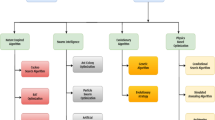Abstract
The rising demands of Wireless Sensor Networks increase day by day because applications of sensors are increases by leap and bound. There are endless applications of WSNs in our daily lives in safety, environmental monitoring, healthcare to animal monitoring, etc. The sensor nodes are operating through the battery. Communication that takes place in the network required a certain amount of battery power. This paper has considered a heterogeneous network scenario, where sensor nodes are deployed and moving at a different speed. Our main objective is to find an energy-efficient cluster. The proposed protocol functions in two phases; phase-i, we classify nodes and form clusters based on the same node speed. In the second phase, the energy consumption of an individual node is computed as well as cluster-wise. Finally, clusters having minimum energy consumption are chosen as energy-efficient clusters. Our simulation has four clusters; result analysis shows that cluster -1 is efficient compared to others. We can conclude that node moving with lower speed consumes a lower amount of energy.











Similar content being viewed by others
References
Anzola, J., Pascual, J., Tarazona, G., & González, R. (2018). A clustering WSN routing protocol based on k-d tree algorithm. Sensors (Switzerland), 18(9), 1–26. https://doi.org/10.3390/s18092899
Behera, T. M., Mohapatra, S. K., Samal, U. C., & Khan, M. S. (2019). Hybrid heterogeneous routing scheme for improved network performance in WSNs for animal tracking. Internet of Things, 6, 100047. https://doi.org/10.1016/j.iot.2019.03.001
Das, I., Shaw, R. N., & Das, S. (2020). Location based and multipath routing performance analysis for energy consumption in wireless sensor networks. In M. N. Favorskaya, S. Mekhilef, R. K. Pandey, & N. Singh (Eds.), Innovations in electrical and electronic engineering. Singapore: Springer. https://doi.org/10.1007/978-981-15-4692-1
Dehghani, S., Pourzaferani, M., & Barekatain, B. (2015). Comparison on energy-efficient cluster based routing algorithms in wireless sensor network. Procedia Computer Science, 72, 535–542. https://doi.org/10.1016/j.procs.2015.12.161
Dimitriou, G., Kikiras, P. K., Stamoulis, G. I., & Avaritsiotis, I. N. (2005). A tool for calculating energy consumption in wireless sensor networks. Lecture Notes in Computer Science (Including Subseries Lecture Notes in Artificial Intelligence and Lecture Notes in Bioinformatics), 3746 LNCS (pp. 611–621). https://doi.org/10.1007/11573036_58.
Kandari, S. (2015). Design of Scenarios for Service Life Estimator Battery Model using QualNet 5.0. International Journal of Computer Networks and Wireless Communications, 5(4), 562–572.
Lakshmi, M., & Prashanth, C. R. (2018). Performance analysis of energy efficient cluster based heterogeneous wireless sensor network against malicious attack. In 3rd International conference on electrical, electronics, communication, computer technologies and optimization techniques, ICEECCOT 2018, (December) (pp. 241–248). https://doi.org/10.1109/ICEECCOT43722.2018.9001655.
Lee, J. G., Chim, S., & Park, H. H. (2019). Energy-efficient cluster-head selection for wireless sensor networks using sampling-based spider monkey optimization. Sensors (Switzerland), 19(23), 5281. https://doi.org/10.3390/s19235281
Marin-Perianu, R. S., Scholten, J., Havinga, P. J. M., & Hartel, P. H. (2008). Cluster-based service discovery for heterogeneous wireless sensor networks. International Journal of Parallel, Emergent and Distributed Systems, 23(4), 325–346. https://doi.org/10.1080/17445760801930948
Pandey, M., Vishwakarma, L. K., & Bhagat, A. (2018). An energy efficient clustering algorithm for increasing lifespan of heterogeneous wireless sensor networks. In Communications in computer and information science (Vol. 828). https://doi.org/10.1007/978-981-10-8660-1_20
Purkar, S. V., & Deshpande, R. S. (2018). Energy efficient clustering protocol to enhance performance of heterogeneous wireless sensor network: EECPEP-HWSN. Journal of Computer Networks and Communications. https://doi.org/10.1155/2018/2078627
Ramya, G., Nagarajan, R., & Kannadhasan, S. (2021). Energy efficient cluster based algorithm technique for wireless sensor networks. IOP Conference Series: Materials Science and Engineering, 1085(1), 012034. https://doi.org/10.1088/1757-899x/1085/1/012034
Raval, A. S. (2015). Cluster head selection for in wireless sensor networks. International Journal of Computer Engineering and Sciences, 1(3), 6. https://doi.org/10.26472/ijces.v1i3.32
Ray, N. K., & Turuk, A. K. (2016). A hybrid energy efficient protocol for mobile ad hoc networks. Journal of Computer Networks and Communications. https://doi.org/10.1155/2016/2861904
Ren, Q., & Yao, G. (2020). An energy-efficient cluster head selection scheme for energy-harvesting wireless sensor networks. Sensors (Switzerland), 20(1), 1–17. https://doi.org/10.3390/s20010187
Rodríguez, A., Del-Valle-Soto, C., & Velázquez, R. (2020). Energy-efficient clustering routing protocol for wireless sensor networks based on yellow saddle goatfish algorithm. Mathematics, 8(9), 1515. https://doi.org/10.3390/math8091515
Samundiswary, P., & Naik, M. R. K. (2013). Performance analysis of deterministic energy efficient clustering protocol for WSN. International Journal of Soft Computing and Engineering, 2(6), 431–435.
Singh, P., & Singh, R. (2019). Energy-efficient qos-aware intelligent hybrid clustered routing protocol for wireless sensor networks. Journal of Sensors. https://doi.org/10.1155/2019/8691878
Thalore, R., Bhattacharya, P. P., & Jha, M. K. (2017). Performance comparison of homogeneous and heterogeneous 3D wireless sensor networks. Journal of Telecommunications and Information Technology, 2017(2), 32–37. https://doi.org/10.26636/jtit.2017.110216
Thandapani, P., Arunachalam, M., & Sundarraj, D. (2020). An energy-efficient clustering and multipath routing for mobile wireless sensor network using game theory. International Journal of Communication Systems, 33(7), 1–18. https://doi.org/10.1002/dac.4336
Torres, M. G. C. (2006). energy consumption in wireless sensor networks using GSP (University of Pittsburgh). https://doi.org/10.1109/ICW.2005.69
Author information
Authors and Affiliations
Corresponding author
Additional information
Publisher's Note
Springer Nature remains neutral with regard to jurisdictional claims in published maps and institutional affiliations.
Rights and permissions
About this article
Cite this article
Das, I., Das, S. Energy Efficient Cluster Analysis for Heterogeneous Wireless Sensor Networks. Wireless Pers Commun 121, 337–352 (2021). https://doi.org/10.1007/s11277-021-08638-2
Accepted:
Published:
Issue Date:
DOI: https://doi.org/10.1007/s11277-021-08638-2




